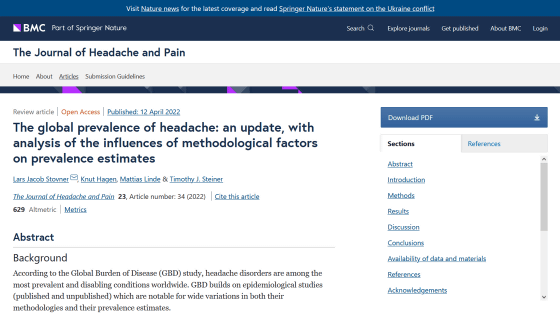It turns out that more than 50% of the world's population suffers from 'headaches'

A research team
The global prevalence of headache: an update, with analysis of the influences of methodological factors on prevalence estimates | The Journal of Headache and Pain | Full Text
https://doi.org/10.1186/s10194-022-01402-2

Not tonight dear --more than half of us suffer from headaches --Scimex
https://www.scimex.org/newsfeed/not-tonight,-ive-got-a-headache-global-estimates-suggest-headaches-impact-over-50-of-the-population
Over 50% of World's Population Is Likely Affected by This Health Disorder Every Year
https://www.sciencealert.com/over-50-of-world-s-population-is-likely-affected-by-this-health-disorder-every-year
The research team reviewed 357 epidemiological headache studies published between 1961 and the end of 2020 to estimate the global prevalence of headache. The subjects included in the study included medical institution examinees, corporate employees, university students, and hospital staff, most of whom were adults aged 20-65, but some were 5 years old. There was also a study targeting children up to and elderly people aged 65 and over.
And as a result of this analysis, it was found that 52% of the world's population experiences some kind of headache every year. As for the breakdown of headaches, 14% of people experience migraine headaches that feel pulsating pain on one side of the head, and 26% experience tension-type headaches that have a feeling of tightness due to mental and physical stress. was. In addition, 4.6% of people experience headaches for 15 days or more a month, and 15.8% of the world's population per day is calculated to suffer from headaches.
In addition, all types of headaches were more common in women than in men, with 8.6% of men suffering from migraine in particular, while 17% of women had migraine. The research team reports that 2.9% of men said they had headaches for more than 15 days a month, compared to 6% of women.

Several measures examined by the research team suggest that the incidence of headaches and migraine headaches may be increasing worldwide, but the proportion of variation between studies that can be explained by the current model. Is less than 30%. 'It's too early to conclude that headaches are decisively increasing,' said Lars Jacob Stovner, the lead author of the paper.
The research team also acknowledges that the research results may not reflect all countries, as the studies reviewed this time are mostly from high-income countries with quality health care systems. .. Therefore, further research into low- and middle-income countries is expected to help determine more accurate estimates.
While there are some ambiguities about the global prevalence of headaches, the results of this study show that headaches are a heavy burden for people around the world. 'We have found that the prevalence of headaches is high worldwide and that the burden of different types of headaches can affect a large number of people. We have prevention and better treatment. Through this effort, we must strive to reduce this burden. To measure the effectiveness of such efforts, we must be able to monitor the spread and burden of headaches in society. How can we study this study? It helps to understand how we can improve our method. '

Related Posts:
in Science, Posted by log1h_ik







